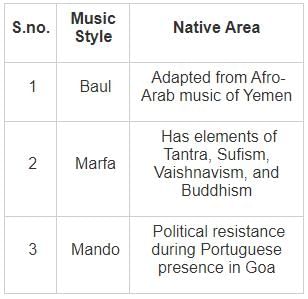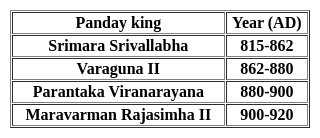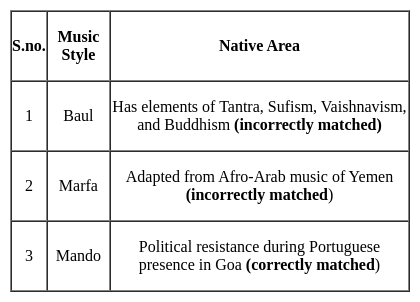UGC NET Paper 2 History Mock Test - 5 - UGC NET MCQ
30 Questions MCQ Test UGC NET Mock Test Series 2025 - UGC NET Paper 2 History Mock Test - 5
Huna tribe is another name of the __________ dynasty in India.
Which of the following Pandya king take help from Sri Lankan king Kassapa-V against Cholas in the battle of Velur.
Where of the following the second Sangam was organized?
With reference to Jainism, consider the following statements:
1. Mahavira was a Kshatriya prince of the Lichchhavis
2. Mahavira taught in the Prakrit language.
3. Jainism was supported by all sections of society.
4. The basic philosophy of Jainism was written after the demise of Mahavira.
Which of the following statements given above are correct?
Consider the following pairs:

Which of the above pairs is/are correctly matched?
Consider the following statements regarding Sher Shah Gate.
1. The gate served as the southern entrance to Shergarh.
2. Shergarh was built when Sher Shah took control of the Mughal Empire after defeating emperor Humayun.
Which among the above statements is/are correct?
With reference to Ryotwari Settlement, consider the following statements:
1) The rent was paid directly by the peasants to the Government.
2) The Government gave Pattas to the Ryots.
3) The lands were surveyed and assessed before being taxed.
Which of the statements given above is/are correct?
Consider the following statements
1). Wood's Despatch laid emphasis on higher education and neglected primary education
2). Macaulayian system was outcome of Orinetalist-Anglicist controversy
Which of the above statement(s) is/are incorrect?
Choose the correct pair:
1) Taluqdar: one who holds a connection.
2) Benami: transactions made in the name of the real beneficiary.
3) Lathyal: functioned as a strongman of the zamindar.
Consider the following pairs:
1) Muzzafarpur Conspiracy Case:- Aurobindo Ghosh and Barinda Kumar Ghosh
2) Alipur Conspiracy Case:- Khudiram Bose and Prafulla Chaki
3) Kakori Conspiracy:- Ram Prasad Bismil, Ashfaqulla Khan
Choose the incorrect pair.
Which of the following was Samudragupta’s policy specifically towards the rulers of Dakshinapatha?
The role of arches in an arcuate architecture was to
A. beautify the superstructure
B. give shape to the superstructure
C. carry the weight of the superstructure
Choose the correct option.
Read the statements (A) and (R) and choose the correct option.
Assertion (A) - During Aurangzeb’s reign, there was a decrease in the number of Mansabdars.
Reason (R) - Their was an increase in the number of jagirs in his reign.
Which strategies were employed for the integration of princely states into the Indian Union?
- Diplomacy
- Persuasion
- Military intervention
- Plebiscite
Who is the author of the book "The Story of the Integration of the Indian States"?
Consider the following statements about Mughal architecture.
1. It retained features from Sultanate architecture such as the bulbous dome and rectangular garden settings.
2. Features from the provincial styles of Gujarat, Malwa, Rajasthan, Sharqi kingdom and Bengal were adopted.
3. New fashions were introduced from Central Asia and Iran such as the arch and vault.
Which of the above statements is/are correct?Which of the following is the correct geographical location for the Ramosi Uprising?
Who was the author of the book ‘Manimekalai’?
With reference to Pallava dynasty, consider the following pairs:
- Seven Ratha Temple: Built by Rajasimha in eight century
- Kailashnath Temple: Built by Narasimhavarman in seventh century
Which of the pairs given above is/are incorrect?
Which one of the following buildings is known as ‘Shan-i-Fatehpur’?
Which of the following Muslim rulers abolished the pilgrimage tax?
On which among the following dates, execution of Bhagat Singh took place ?
Consider the following Maratha Powers with treaties which they had with British:
- Peshwa – Treaty of Bassein
- Bhonsle – Treaty of Deogaon
- Sindhia – Treaty of Surji Anjangaon
Which of the above is/are correct?
What was the primary objective of the East India Company in India?
|
92 docs|125 tests
|

















